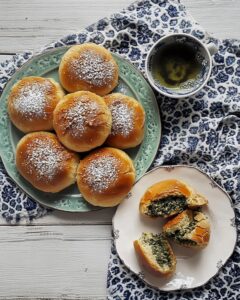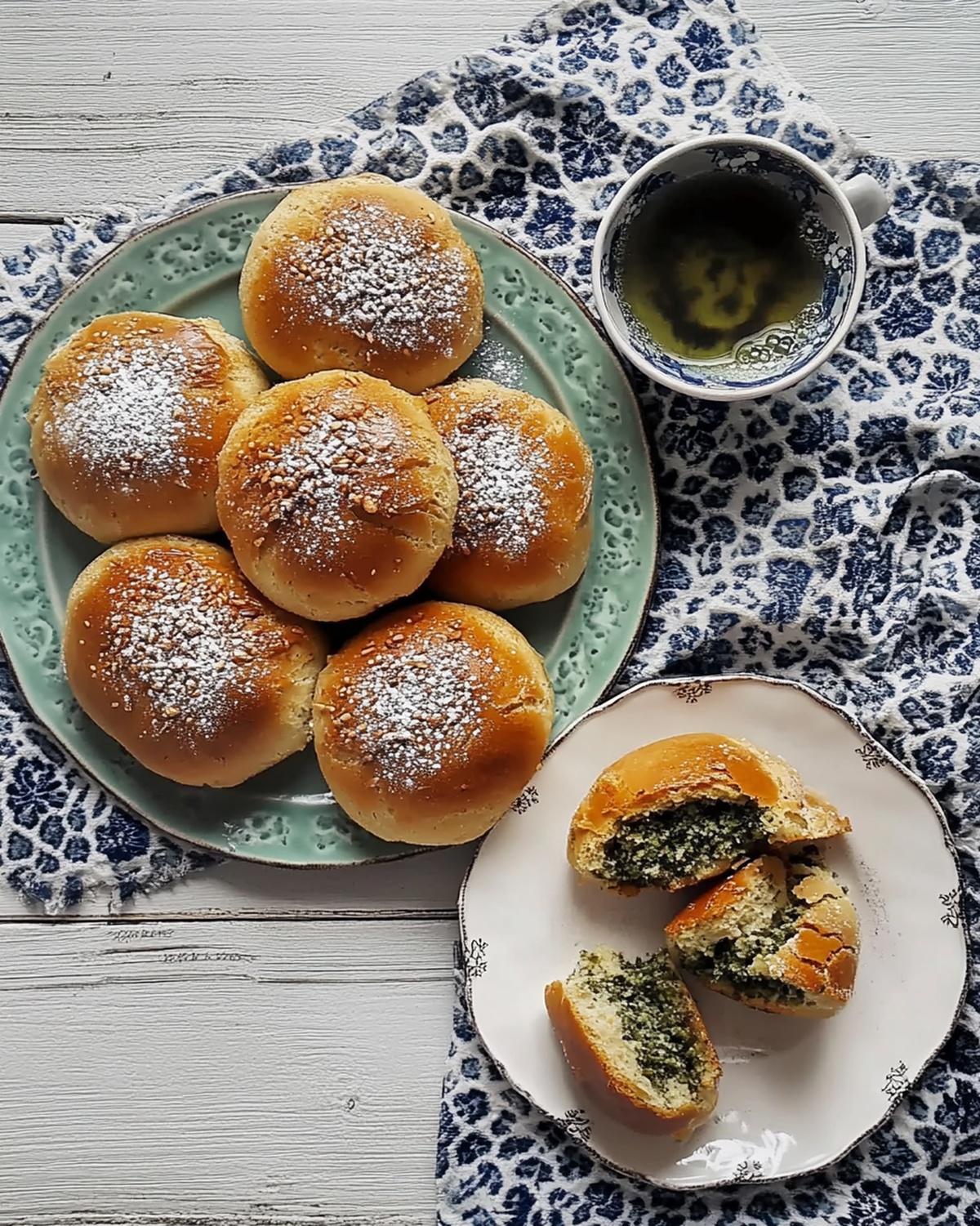Homemade Turkish Pogaca Recipe: Fluffy Savory Delights
Soft, buttery turkish pogaca brings a delightful twist to your morning routine.
Bakers in istanbul have perfected this delectable pastry over generations.
Flaky layers melt in your mouth with every bite.
Salt and herbs create a complex flavor profile that surprises the palate.
Small pockets of cheese nestled inside add a creamy richness.
Mediterranean coastal regions inspire this traditional bread’s unique texture and taste.
Warm from the oven, these savory treats will make you feel connected to turkish culinary traditions.
Dive into this recipe and experience a slice of istanbul’s breakfast magic.
Why You’ll Love Turkish Pogaca Every Time
What Goes In Turkish Pogaca
Main Ingredients:Filling Ingredients:Seasoning and Binding Ingredients:How To Bake Turkish Pogaca Right
Step 1: Create Soft Dough Base
In a spacious mixing bowl, combine flour, instant yeast, sugar, and salt. Whisk these dry ingredients together thoroughly to ensure even distribution.
Step 2: Develop Dough Consistency
Pour warm milk into the dry mixture, add vegetable oil, and egg white. Stir and blend until a smooth, cohesive dough emerges.
The texture should feel soft and slightly tacky.
Step 3: Knead and Rise Dough
Transfer the dough onto a clean surface and knead vigorously for 8-10 minutes.
Work the dough until it becomes elastic and silky. Place the dough in a covered bowl and allow it to rise in a warm spot for approximately one hour, or until it doubles in size.
Step 4: Prepare Delicious Fillings
While dough rises, prepare your filling ingredients:Gently mix these ingredients together in a separate small bowl.
Step 5: Shape Pogaca Pastries
Divide the risen dough into eight equal portions.
Flatten each piece into a circular shape, place a spoonful of feta-parsley mixture in the center, and carefully fold and seal the edges to create a pocket.
Step 6: Bake Golden Pogaca
Preheat the oven to 375°F.
Arrange the filled dough pockets on a baking sheet. Brush the tops with egg yolk for a beautiful golden finish.
Bake for 20-25 minutes until the pogacas turn a rich, warm brown color.
Smart Tips For Turkish Pogaca
Flavor Spins On Turkish Pogaca
What Goes Well With Turkish Pogaca
How To Store Turkish Pogaca Properly
FAQs For Turkish Pogaca Explained
Pogaca is a traditional pastry that originated in Turkey, commonly enjoyed as a breakfast or snack item across Turkish households and bakeries.
Yes, while feta cheese and parsley are classic, you can experiment with other fillings like ground meat, potato, or olives to suit your taste preferences.
Pogaca is similar to other Mediterranean and Middle Eastern stuffed bread varieties, but has a unique soft texture and distinct Turkish preparation method.
This recipe is relatively easy for home bakers with basic bread-making skills, requiring simple ingredients and straightforward kneading and filling techniques.
Print
Turkish Pogaca Recipe
- Total Time: 1 hour 20-25 minutes
- Yield: 12 1x
Description
Savory Turkish Pogaca pastries offer a delightful journey through traditional bakery magic, blending delicate herbs with rich, buttery dough. Crisp exterior and tender crumb invite you to savor each delectable bite of this beloved Turkish comfort classic.
Ingredients
Main Ingredients:
- 2.5 cups all-purpose flour
- 1/2 cup feta cheese (crumbled)
Leavening and Seasoning:
- 1 teaspoon instant yeast
- 1 teaspoon sugar
- 1 teaspoon salt
Liquid and Binding Ingredients:
- 1/2 cup warm milk
- 1/4 cup vegetable oil
- 1 egg (divided, with yolk for brushing)
- Fresh parsley (chopped, optional)
Instructions
- Combine flour, yeast, sugar, and salt in a spacious mixing bowl, creating a dry ingredient foundation.
- Pour warm milk, vegetable oil, and egg white into the dry mixture, gently stirring until a cohesive, soft dough emerges.
- Thoroughly knead the dough for 8-10 minutes, developing a smooth and elastic texture. Cover and allow to rest and rise in a warm environment for approximately 60 minutes.
- Heat the oven to 375°F (190°C), preparing for baking.
- Partition the risen dough into 8 uniform segments, ensuring equal sizing.
- Gently flatten each dough portion into a circular shape, creating a delicate surface for filling.
- Sprinkle feta cheese and finely chopped parsley at the center of each flattened dough piece.
- Carefully fold and seal the edges, encasing the cheese and parsley filling completely.
- Arrange the filled pogaca on a prepared baking tray, maintaining slight separation between each piece.
- Delicately brush the surface of each pogaca with egg yolk, enhancing color and shine.
- Bake in the preheated oven for 20-25 minutes until achieving a rich, golden-brown exterior.
Notes
- Ensure milk is warm but not hot to activate yeast without killing it, which helps create soft, fluffy pogaca.
- Use fresh feta cheese and finely chopped parsley for maximum flavor and authentic Turkish taste.
- Knead dough thoroughly to develop gluten, creating a stretchy texture that helps seal fillings securely.
- For gluten-free version, substitute wheat flour with almond or rice flour, and add xanthan gum for better binding.
- Prep Time: 1 hour
- Cook Time: 20-25 minutes
- Category: Breakfast, Snacks
- Method: Baking
- Cuisine: Turkish
Nutrition
- Serving Size: 12
- Calories: 200
- Sugar: 1 g
- Sodium: 250 mg
- Fat: 10 g
- Saturated Fat: 2 g
- Unsaturated Fat: 8 g
- Trans Fat: 0 g
- Carbohydrates: 25 g
- Fiber: 1 g
- Protein: 6 g
- Cholesterol: 30 mg




Truc Tran (Kris)
Senior Food Editor
Expertise
Home Cooking, Meal Planning, Recipe Development, Baking and Pastry, Food Editor, Cooking-video Maker, Vietnamese Food Evaluation Expert
Education
Truc Tran (Kris), an experienced food writer and editor, is great at exploring and describing global cuisines, from simple street food to fancy dining. In her writing, she skillfully mixes different flavors, cooking methods, and culinary traditions, showing the unique character of various cultures through their food and drinks. On azcuisines.com, Kris highlights her knowledge, especially in Asian cuisine and worldwide traditional dishes.